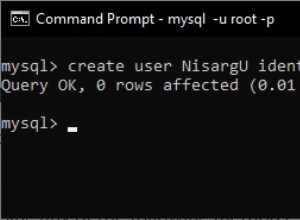Erstens, wenn es sich um Code handelt, der in der Produktion verwendet werden soll, stellen Sie bitte sicher, dass Sie Ihre SQL-Parameter maskieren, bevor Sie sie in Ihre Anweisung einfügen. Niemand freut sich über einen SQL-Injection-Angriff. Ich würde stattdessen die Verwendung von PDO empfehlen, da es vorbereitete Anweisungen und Parameterbindungen unterstützt, was viel sicherer ist.
Wie kann ich die SQL-Injection in PHP verhindern?
Sie haben also ein Formular...
[title]
[details]
[submit]
Und das wird in Ihre Datenbank eingefügt...
INSERT INTO questions (title, details) VALUES (?, ?)
Sie können die letzte Insert-ID mit mysql_insert_id abrufen , http://php.net/manual/en/function. mysql-insert-id.php
.
$id = mysql_insert_id();
Dann kannst du dir die Aufzeichnung holen...
SELECT title, details FROM questions WHERE id = ?
Und in einer Vorschauseite ausgeben.
Ich habe ein Beispiel geschrieben, das PDO anstelle der grundlegenden MySQL-Funktionen verwendet.
form.php :
<form action="process.php" method="post">
<label for="question_title">Title</label>
<input id="question_title" name="title"/>
<label for="question_detail">Detail</label>
<input id="question_detail" name="detail"/>
<button type="submit">Submit</button>
</form>
process.php :
<?php
// Create a database connection
$pdo = new PDO("mysql:dbname=test");
// Prepare the insert statement and bind parameters
$stmt = $pdo->prepare("INSERT INTO questions (title, detail) VALUES (?, ?)");
$stmt->bindValue(1, $_POST["title"], PDO::PARAM_STR);
$stmt->bindValue(2, $_POST["detail"], PDO::PARAM_STR);
// Execute the insert statement
$stmt->execute();
// Retrieve the id
$id = $stmt->lastInsertId();
// Prepare a select statement and bind the id parameter
$stmt = $pdo->prepare("SELECT title, detail FROM questions WHERE id = ?");
$stmt->bindValue(1, $id, PDO::PARAM_INT);
// Execute the select statement
$stmt->execute();
// Retrieve the record as an associative array
$row = $stmt->fetch(PDO::FETCH_ASSOC);
?>
<h1><?php echo htmlspecialchars($row["title"]);?></h1>
<p><?php echo htmlspecialchars($row["detail"]);?></p>
Ohne PDO...
form.php :
<form action="process.php" method="post">
<label for="question_title">Title</label>
<input id="question_title" name="title"/>
<label for="question_detail">Detail</label>
<input id="question_detail" name="detail"/>
<button type="submit">Submit</button>
</form>
process.php :
<?php
// Create a database connection
$conn = mysql_connect();
// Execute the insert statement safely
mysql_query("INSERT INTO questions (title, detail) VALUES ('" .
mysql_real_escape_string($_POST["title"]) . "','" .
mysql_real_escape_string($_POST["detail"]) . "')", $conn);
// Retrieve the id
$id = mysql_insert_id($conn);
// Close the connection
mysql_close($conn);
header("Location: question_preview.php?id=$id");
question_preview.php :
<?php
// Create a database connection
$conn = mysql_connect();
// Execute a select statement safely
$result = mysql_query("SELECT title, detail FROM questions WHERE id = " .
mysql_real_escape_string($_GET["id"]), $conn);
// Retrieve the record as an associative array
$row = mysql_fetch_assoc($result);
// Close the connection
mysql_close($conn);
?>
<h1><?php echo htmlspecialchars($row["title"]);?></h1>
<p><?php echo htmlspecialchars($row["detail"]);?></p>




